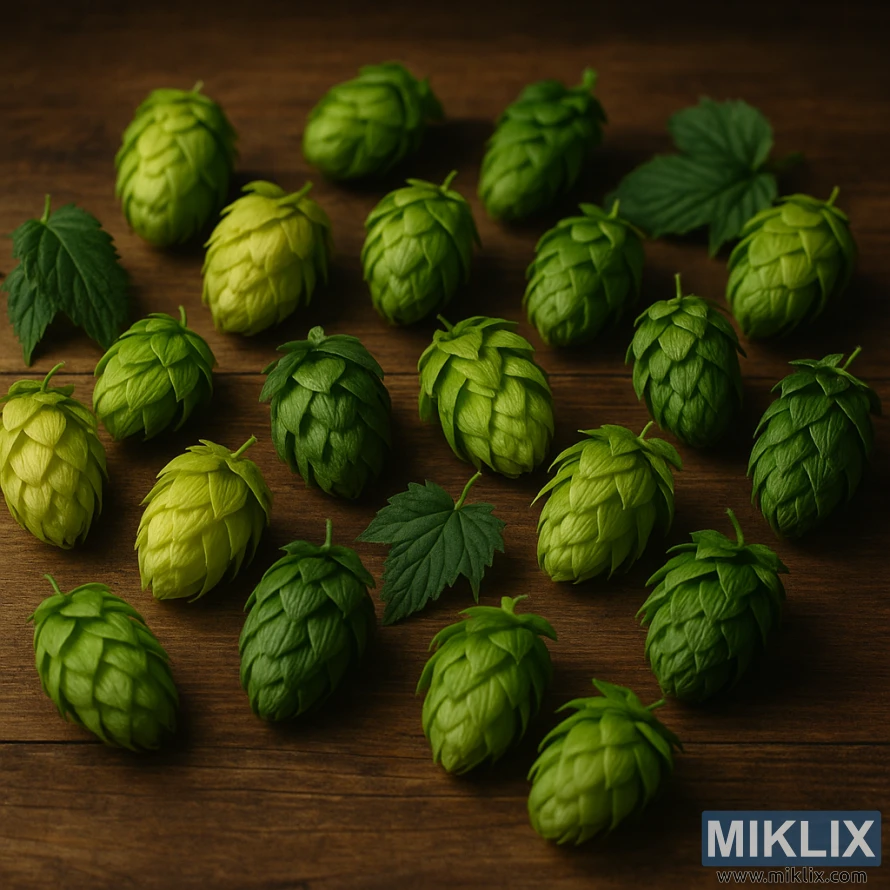Image: Still Life of Hop Varieties as Tahoma Substitutes
Published: October 23, 2025 at 9:38:46 PM UTC
A rustic still life of hop cones in different shades of green, displayed on a wooden table with soft lighting to highlight substitutes for Tahoma hops in brewing.
The photograph presents a carefully arranged still life of hop cones laid out across a rustic wooden table, offering a visual exploration of Tahoma hop substitutes through texture, color, and form. The wooden surface beneath the cones is warm and richly grained, its natural imperfections and tonal variations contributing to a sense of earthiness and tradition. This backdrop, simple yet elegant, evokes the craft and authenticity of brewing while grounding the subject in a tactile, natural environment.
Spread across the table are numerous freshly harvested hop cones, each distinct in its size, shape, and hue. Their coloration ranges from pale, almost lime-green at the lighter end of the spectrum, to deep, saturated forest greens. This variation not only emphasizes the individuality of each hop variety but also mirrors the diversity of aromas, bitterness levels, and flavor profiles that brewers can explore when substituting Tahoma.
The cones themselves are rendered in remarkable detail. Their papery bracts overlap in tightly packed layers, creating intricate geometric patterns reminiscent of pinecones, though softer and more delicate. The subtle veins running across the bracts catch the soft, diffused light, producing a play of highlights and shadows that emphasizes texture and depth. Some cones appear elongated and tapered, while others are more compact and rounded, hinting at the genetic differences and brewing characteristics between hop varieties.
Interspersed among the cones are a few green hop leaves, broad and serrated, which provide a contrasting flatness to the dimensional cones. Their presence reinforces the natural origin of the cones and adds visual balance to the composition. The placement of the cones and leaves appears both organic and intentional—some overlapping slightly, others spaced to allow their form to be individually appreciated.
Lighting plays a central role in the image’s atmosphere. A soft, diffused glow illuminates the scene from an angle, casting gentle shadows that stretch across the table. This subdued lighting avoids harsh contrasts, instead emphasizing subtle textures: the fibrous layers of the cones, the fine serrations of the leaves, and the weathered ridges of the wooden surface. The result is a calm, almost meditative ambiance, inviting the viewer to linger over the details.
Symbolically, the photograph extends beyond aesthetics to suggest possibility and exploration in brewing. By presenting hop cones as a diverse collection, the composition underscores the breadth of substitutes available to brewers when Tahoma is not at hand. Each cone seems to embody a different brewing story, promising distinctive aromas of citrus, pine, spice, or floral character, depending on its lineage. The rustic table, the organic arrangement, and the honest lighting together communicate a philosophy of craft: brewing as an intimate dialogue between raw ingredients and the brewer’s creative intent.
Altogether, the image radiates vitality, natural abundance, and sensory richness. It not only celebrates hops as the botanical foundation of beer but also conveys the joy of discovery in seeking out alternatives, reminding us that brewing is as much about variety and experimentation as it is about tradition.
The image is related to: Hops in Beer Brewing: Tahoma

